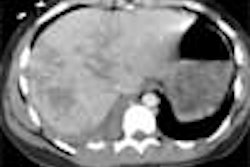CHICAGO - European researchers took a good long look at automated CO2 insufflation in virtual colonoscopy at the RSNA meeting on Tuesday -- and came away mostly upbeat.
"Optimizing patient distension is a key consideration when performing virtual colonoscopy," explained Dr. Franco Iafrate from the University of Rome "La Sapienza" at the 2004 RNSA meeting on Tuesday. "During CT colonography (VC) if too many collapsed segments are present, clinically important lesions could be missed."
Patient discomfort is a second major consideration, he said. Patients who are dissatisfied with VC have specifically mentioned bowel insufflation as a contributing factor in their discomfort. In addition, the use of CO2 insufflation rather than air has been reported to reduce cramps, bloating, and discomfort associated with virtual colonoscopy, due in part to the fact that much of the induced CO2 can be absorbed through the colonic mucosa, while most induced room air must be expelled.
The Italian study sought to compare mechanical CO2 bowel insufflation using an automated device (ProtoCOl, E-Z-EM, Lake Success, New York) with manual room air insufflation. The group examined 168 patients (97 men and 71 women ages 19-89). The group included 67 asymptomatic screening patients, 42 with diverticulosis, 31 who had an incomplete colonoscopy, and 28 with abdominal pain and cramping, Iafrate said.
Following cathartic bowel cleansing with either 4 L of SELG (n = 117) or diatrizoate meglumine (n = 51), the patients were randomized into two groups. Group 1 (n = 84) had automated colonic insufflation with CO2; group 2 (n = 84) underwent manual room air insufflation. No intravenous contrast or antispasmodic agents were used.
The automated ProtoCOl device was used to pump an average 2.4 L of CO2 (or a maximum 4 L) into each patient. First 2 L were administered with the patient in lateral position, then additional gas was given with the patient either prone or supine until distension was deemed adequate on the CT scout view.
Colonic distension in each segment of the colon (rectum, sigmoid colon, descending colon, transverse colon, ascending colon, and cecum) was graded for both prone and supine phases of the exam -- graded on a scale of 0 to 3, with 3 denoting optimal distension. For the 84 patients in group 2, manual room air insufflation was given to patient tolerance.
The results showed only minor differences between the two patient groups. For example, in the automated insufflation group (1) with 1,008 segments evaluated, 496 segments were graded 3, 402 segments were graded 2, 90 were graded 1, and 20 were graded 0, denoting a collapsed segment. In the manual room air insufflation group (2) with 1,002 segments evaluated, 639 segments were rated 3, 275 were rated 2, 55 were rated 1 for poor distension, and 33 were rated 0.
In all, 898/1008 automated insufflation segments were rated good or optimal (3, 2) compared to 914/1002 segments rated good or optimal among the manual room-air-insufflated patients.
"So the use of CO2 had no effect on overall effectiveness of colonic distension," Iafrate said.
Patients expressed a clear preference for CO2 when asked to rate bloating and discomfort, however. The questionnaire consisted of a scale drawn between no bloating and severe bloating and between no discomfort and severe discomfort, both during and 30 minutes after virtual colonoscopy.
Fifty-seven percent of the CO2 patients reported no pain during the procedure, compared with 25% of the manually insufflated patients. For mild, moderate, severe, and extreme pain, the percentages were 36%, 7%, 0, and 0 for the CO2 patients, respectively; versus 34%, 43%, 8%, and 1% for the manually insufflated patients, respectively. Thirty minutes after the exam, the same subjective pain responses were 60% (no pain), 38% (mild), 2% (moderate), and 0 (severe and extreme) for the CO2 group, versus 43%, 30%, 23%, 3%, and 1%, respectively, for the manually insufflated group.
Finally ileocecal valve reflux was reported in 51% of the CO2 group versus 82% of the manual air group (p < 0.01), "probably due to the (greater) volume of air introduced," Iafrate said. However, insufflation took longer with the automated device, three minutes on average, compared to 45 seconds for manual air.
"The adequacy of distension was graded optimal in all groups, and there was no significant difference among each segment," Iafrate concluded. "Insufflation using a mechanical CO2 pump is much better tolerated than air distension by the patients. Diffusion of C02 through the colonic wall is extremely rapid compared with air, diminishing the presence of ileocecal valve reflux."
In Berlin, better distension through automation
"In contrast to the previous paper, we opted to use CO2 gas for both manual and automated insufflation," said Dr. Patrick Rogalla from Charité Hospital in Berlin in the next RSNA presentation. In his group's study, a total of 201 asymptomatic patients underwent VC for the detection of colonic polyps. (Approximately 20 patients in each group had diverticular disease.)
Group 1 (92 patients, average age 55 years) had CO2 administered with a manual pump, which uses a thumb-release technique to release the gas into the patient to maximum tolerance.
Group 2 (92 patients, average age 57 years) were insufflated using the automated E-Z-EM ProtoCOl device. The automated device insufflates the patient automatically, maintaining a maximum pressure of 25 mmHg throughout CT imaging, and providing an automatic flow-stop feature to protect against overinsufflation.
All patients were premedicated intravenously with butylscopalamine prior to colonic insufflation, and all received a double-dose phosphosoda laxative preparation the day before imaging. Finally, patients received two 30-mL doses of oral contrast, and 120 mL of IV contrast with a 60-second scan delay.
CT imaging was performed using 120 kVp, 63 effective mAs, with dose modulation added to lower it further, 1-mm slice thickness, 0.18-mm table increment, Rogalla said. Supine imaging was conducted in all patients, but prone imaging was reserved for those patients who had collapsed segments in prone imaging.
The colon, divided into seven segments, was assessed for length, total volume, radial distensibility, and number of nondistended segments for each patient, and compared for both groups automatically on the workstation, Rogalla said.
According to the results, there was no overall difference in colon length between the manual and automated groups (165 cm for both). The mean volume and radial distensibility of the colon were 2.08 I and 3.9 cm, respectively, using manual insufflation, and 2.32 I and 4.255 cm using the automated device (p = 0.015).
"However, we did see a significant difference in the volume of the colon between the manual and automatically insufflated group, and also the average distension was significantly better in the group that received the CO2 gas through the device," he said. "I think the most crucial part is the number of collapsed segments in those groups, and this was highly significant. We only had one segment that was not distended in the (automated) group," versus 17 collapsed segments in the manually insufflated group.
"We believe that the constant pressure of the (automated) device is the key feature that keeps the bowel open, and also I think it is a means of dose reduction, because we actually can lower the number of prone scans in the group that received CO2 gas through the device," Rogalla said. "So we can conclude that automatic pressure-controlled carbon dioxide insufflation may be recommended for (VC) in the supine patient."
By Eric Barnes
AuntMinnie.com staff writer
December 1, 2004
Related Reading
Electronic CO2 insufflation beats air in virtual
colonoscopy, March 12, 2003
Copyright © 2004 AuntMinnie.com



















